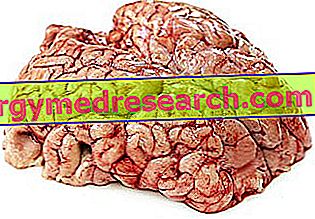Definition and outline
From the chemical point of view, lactic acid (C 3 H 6 O 3 ) is defined as a carboxylic acid whose deprotonation gives rise to the lactate ion.
In human physiology, lactic acid is the waste of energy production in the absence of oxygen, or anaerobic glycolysis.

For some physiological systems the production of lactic acid is absolutely normal (red blood cells), but the vast majority of body tissues mainly uses aerobic metabolism (ie in the presence of oxygen); muscle tissue is one of them.
Lactic acid and sports performance

The stimulation of the lactacid metabolism occurs effectively through the execution of repetitions above the anaerobic threshold or of rhythmic variations above the anaerobic threshold; remember that the anaerobic lactate metabolism is very useful thanks to the speed with which it supplies energy, but on the other hand, it is extremely limiting since the accumulation of lactic acid represents an element of great muscle fatigue and therefore limits the continuation of the performance .
Lactic acid is disposed of via neoglucogenesis or Cori cycle, ESPECIALLY in the liver, reached through the circulatory system, and to a lesser extent in skeletal muscle and heart. It is also worth mentioning that, in optimal physical and athletic conditions, the disposal of lactic acid does NOT extend beyond 120 ', moreover, lactate is NOT responsible for post-exercise muscle pain (in English Delayed onset muscle soreness- DOMS), instead caused by the release of intracellular molecules (for micro-lacerations) consequently to very intense training and above all with "eccentric" efforts. These molecules generate a real localized inflammation, effectively stimulating the neuromuscular terminations and inducing the sensation of PAIN.
Dispose of lactic acid
In sports performance, the ability to produce lactic acid, to tolerate muscle concentrations and to dispose of it quickly, are qualities deliberately sought through different and specific training.
In order to reduce the acid-induced attic symptoms, the athlete should:
- Strengthen disposal mechanisms (muscle vasculature, enzyme increase in liver and muscle, and increase of buffer systems)
- Perform useful disposal activities (muscle fatigue or active recovery between one repetition and another, or reduction in intensity to a tiring level during rhythm changes)
- Ensure the supply of magnesium and possibly supplement with alkalizing products
Remedies for lactic acid
As already specified, lactic acid is a very useful "waste" molecule, as it represents a potential neoglucogenetic substrate from which to obtain new glucose. Obviously, in the event that the production of this catabolite exceeds the disposal capacity, there would be an accumulation of acid molecules responsible for muscular performance decline and systemic fatigue. Under physiological conditions, the acidification of the blood induced by lactic acid is absolutely harmless and even during maximal performance it SHOULD NOT cause any kind of acute complication; obviously, taking for granted that the athlete or sportsman in question is physically healthy, well hydrated and trained. However, in order to improve the performance of the disciplines that massively involve the anaerobic lactacid metabolism, sports technicians and nutrition professionals have begun the search for different remedies to counteract their accumulation or reduce their symptoms; it is however necessary to specify that no nutritional intervention and no food supplementation can replace a specific training to increase the lactic acid tolerance.
1) Magnesium (Mg), a natural alkalizing agent
Magnesium is a trace element that is widely used in foods but whose needs increase drastically in athletes and especially in endurance athletes. Its concentration in extracellular fluids is fundamental to maintaining the membrane potential of nerves and muscles as well as for the transmission of the nerve impulse, two physiologically severe and SEVERED processes due to the accumulation of lactic acid. It can be deduced that a lack of magnesium (even if not excessive but chronic) could negatively affect the maintenance of the prolonged and high intensity muscle stimulus; therefore, it is not uncommon for chronic magnesium insufficiency to be confused with lactate accumulation induced by excessive training intensity. Such a situation could literally mislead sports technicians, causing them to lighten the training tables and consequently nullify the entire organization of the annual program. In the long term, magnesium deficiency MAY more than realistically simulate overtraining or overtraining symptoms.
LARN quote: " Magnesium homeostasis is substantially guaranteed by renal function and absorption modulation at the intestinal level ... Given the widespread presence of magnesium in food and the high efficiency of magnesium retention by the kidney, not there are known cases of SPONTANEOUS food deficiency of magnesium.The magnesium deficiency manifests itself with altered metabolism of calcium, sodium and potassium which results in muscle weakness, impaired cardiac function and even tetanic crises ".
Magnesium is present: in green vegetables, bananas, legumes, whole grains and dried fruits, although more than 80% of magnesium is removed from grain refining treatments . In the healthy NON-sporting subject, contributions from 3 to 4.5 mg / kg are sufficient, however, data are lacking to establish the right recommended intake level; the recommended safety interval is 150 to 500 mg / day .
Magnesium does not intervene directly on the lactic acid infill system but its deficiency can aggravate the symptoms of muscle build-up, therefore, among the remedies against the undesirable effects of lactic acid it would be desirable to introduce an adequate diet, probably supported by the magnesium food supplementation.
2) Bicarbonate
Bicarbonate is an alkalizing molecule produced physiologically by the body that is part of the buffer system; it includes bicarbonate, phosphate, amino acids (such as histidine) and some proteins (such as hemoglobin). The bicarbonate reacts by binding the hydrogen ions (H +) released by acidic substances (such as lactic acid) reducing its acidification potential. It can be used as a food supplement if taken from 30 minutes to 2 hours before the performance; in fact, a study on middle distance researchers has shown that the administration of sodium bicarbonate equal to 300mg per kg of body weight increases both the concentration of bicarbonate and the blood pH with a relative improvement in the performance in the competition. A further study was carried out on a female sample that, for the same administration, in performing a maximum effort of 60 'obtained an improvement in the extracellular buffer system.
The side effects of excessive sodium bicarbonate supplementation are enteric in nature (diarrhea) and affect 50% of the athletes who use it. The optimal intake could be 300mg (0.3g) of bicarbonate per kg of body weight.
The sodium brought by the integration of bicarbonate makes it unsuitable for the treatment of athletes and athletes suffering from hypertension.
3) Calcium carbonate
Calcium carbonate (-CaCO 3 -) is a product mainly used in the treatment of stomach acid, as it has a greater gastric permanence (even if only slightly) than sodium bicarbonate; its metabolic efficacy is however comparable to the one mentioned above but prolonged consumption can negatively affect intestinal peristalsis causing constipation.
4) Magnesium hydrate and aluminum hydrate
Also the magnesium hydrate [Mg (OH) 2 ] and the aluminum hydrate [Al (OH) 3 ] are weak bases used as antacids, but even though they boast greater therapeutic characteristics, their intake does not alter the quantity in a decisive manner of bicarbonate blood; therefore, their use for sports purposes is not comparable to that of baking soda.
5) Carnosine
Carnosine is a dipeptide formed by B-alanine and histidine; its therapeutic use is fundamentally PRO-cicatrizant but in the sparse field liquid carnosine injections are administered to improve maximal performance. It seems that carnosine is among the most effective remedies against the accumulation of lactic acid, increasing resistance and improving overall work capacity. Carnosine is able to buffer lactic acid thanks to the intervention of histidine, while alanine is used as a neoglucogenetic substrate.
The oral intake of carnosine must be carried out a few hours before performance and the doses of intake are between 50 and 1000mg / day.
Bibliography:
- Recommended Nutrient Intake Levels for the Italian Population (LARN) - Italian Human Nutrition Society (SINU)



